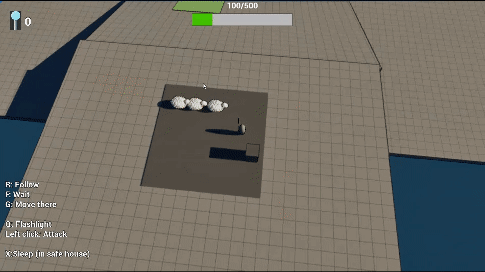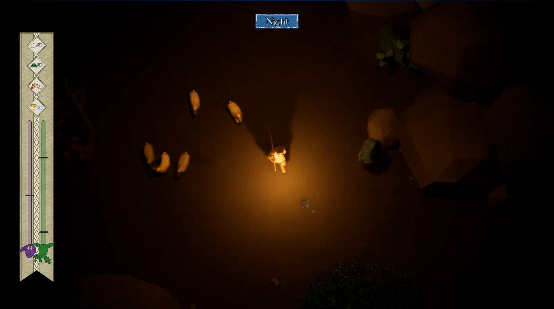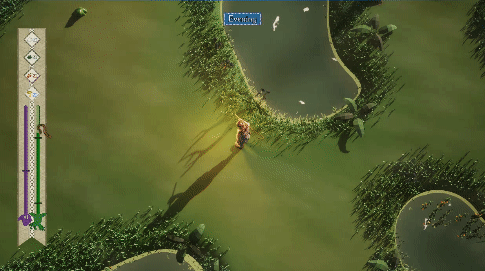Sheepwatch
Concept
Take on the role of a shepherd, navigating tranquil landscapes while managing your flock's well-being and grazing needs. As night descends, hidden threats emerge, and you must defend your sheep from dangerous creatures that roam the darkness.
This game was created as a school project, with our team aiming to deliver a unique experience within the constraints of a four week full production schedule and the given theme of "Antagonists."
Role & Contributions
Systems & Gameplay Design: Designed and implemented core mechanics and systems.
Game Vision & Documentation: Maintained game vision and updated the Game Design Document to align team goals.
Scrum Master: Facilitated team coordination and collaboration.
Key Feature - Time Management
1. Designed game concept around a time of day system.
2. Created an easy to implement time tracking system for actors.
3. Designed and implemented how sleep impacts sheep hunger and sanity.
4. After playtesting, I added animated arrows to clearly indicate how sleep affects hunger and sanity.
Core Loop
Explore world
Explore to find grazing locations and pickups.
Goal:
Grow your herd!
Return home
Buy upgrades, sleep and have sheep reproduce if they are well fed.
Protect sheep
Manage sheep hunger and sanity, while protecting them from creatures during the night.
Pillars
1. Approachable
Simple controls, clear mechanics, and gradually introduced complexity. Challenges stem from strategic decisions rather than dexterity.
3. Strong connection with sheep
The game encourages players to build a bond with the flock and feel a sense of responsibility.
2. Risk/reward
The game emphasizes a risk-reward dynamic, where most actions involve weighing potential benefits against the associated risks.
4. Danger lurks
Even moments of safety carry an undercurrent of unease, reinforcing the presence of threats.
Pre-production
The course spanned 6 weeks, with 2 of those weeks dedicated to pre-production for exploring and testing ideas before moving the main concept into full production.
Finding the Concept
On day one, our team discussed goals and interests. With a focus on AI and gameplay design, we aimed to align our strengths with the assigned theme, antagonists.
I brainstormed ideas leveraging AI-to-AI interactions, where players influence NPC dynamics. Drawing inspiration from Dredge’s day-night cycle and mechanics, I developed the idea of Sheepwatch: a game where players protect a flock from night predators. I outlined the core loop, key mechanics, inspirations, and ideas for visual style. I pitched this idea to the rest of the team and got a very positive response.
While designing the game, I analyzed Dredge’s structure to understand how it encourages player behavior, then began mapping potential design challenges unique to Sheepwatch and how to solve them.
Prototyping and Exploring Core Systems
During prototyping, I developed the game’s self-regulating difficulty system, adjusting challenges based on the player's situation. Managing a large flock increases difficulty due to more food required, while fewer sheep make gameplay easier, reducing food needs and making it easier to avoid the dangerous nights. My goal was to create a negative feedback loop that increases difficulty gradually but eases it if the player struggles.
After a few days of prototyping, Sheepwatch showed the most potential. We explored three versions of it, including the first-person prototype I focused on and a top-down version, which was how some team members had envisioned it from the start. For the top-down view prototype, I designed and implemented a point-and-click system for sheep control, creating an intuitive gameplay experience.

During playtesting with industry professionals, their feedback indicated that they found the top-down perspective the most engaging, which aligned with our team's preference after seeing the prototypes. With the concept, controls, and perspective set, we were ready to move Sheepwatch into full production.
Production Plan and Setting Up GDD
I collaborated with the product owner to create a production plan, outlining the epics and establishing timelines aligned with our milestones: alpha (feature freeze) and beta (content freeze). This structured approach allowed us to monitor the progress of each epic effectively.

At this stage, I worked closely with the other designers to refine the game’s design and began drafting the design document on Miro. Maintaining this document was a high priority, as it provided programmers with clear and concise instructions for their tasks. I was responsible for designing, writing, and regularly updating the document throughout the entire project.
Production
The final four weeks of the six-week project were dedicated entirely to full production, with every team member fully focused on bringing the game to life.
Hunger System
As time passes, sheep's hunger bar gradually decreases. If their hunger level drops below 20%, there’s a chance each in-game hour that a sheep might die, with this risk increasing as hunger worsens. I expanded upon this system by integrating in-game hour triggering, adding adjustable variables to control its trigger probability, and implementing mechanics for managing sheep death.

Sheep graze on grass patches, a core feature that motivates player to move around the world. I tweaked this mechanic so that larger flocks consume grass faster, adding realism and impacting gameplay. As flock size grows, the total hunger also increases, pushing players to seek food farther away, often at night when dangers rise, aligning with the game’s intended self regulating difficulty. I added the functionality of grass patches shrinking based on the remaining grass points.

Sanity System
Below a certain threshold, low sheep sanity increases the hourly chance of a sheep panicking and fleeing the herd. Players can regain control by approaching and calming them. Sanity decreases at night, recovers gradually during the day, and replenishes quickly with sleep. It also drops instantly during werewolf attacks. My goal with the sanity system is to encourage players to return home regularly to sleep, rewarding those who embrace the game’s cyclical rhythm.
Managing Hunger and Sanity
Players can manage hunger and sanity as interchangeable resources. Sleeping restores sanity but drains hunger, while grazing at night boosts hunger but decreases sanity. This dynamic compels players to make strategic decisions.
To aid in these choices, I implemented an animated UI element that indicates how hunger and sanity will change based on sleep duration. This system calculates the in-game hours until the player wakes up, determines the impact on hunger, and applies the new values upon selecting "sleep". Since players can sleep at any in-game hour and wake up during any of the four segments (morning, midday, evening, night), the calculations proved more complex than anticipated.
Sleep menu and hunger/sleep preview system
Time Tracking Actors
The day-night cycle is a core mechanic, determining when grass patches, pickups, and enemies appear. The in-game day is divided into four segments- morning, midday, evening, and night. To allow actors to track how many of these segments have passed, I developed a system that enables team members to easily add a time-tracking component to any actor.
This system triggers events for all actors with a specific interface whenever the time of day changes. Each actor's component tracks time, activating custom logic after a defined number of day segments. The interface manages communication between the actor, time-tracking component, and day-night controller, reducing dependencies and avoiding hard references. This modular setup ensured flexibility and easy integration across game elements.
Keep track of time in component
Keep track of time in component owning actor
Enemy AI
I designed the full behavior of the game’s two enemies, the Werewolf and the Lost Spirit, collaborating closely with a programmer to implement them. I frequently playtested updates to ensure each behavior aligned with the game’s intended experience. I also made tweaks to the enemies myself.
Werewolf
My goal with the Werewolf was to create a sense of being stalked at night and encourage players to stay close to the herd. Players can temporarily scare it off by getting close and shining a light on it. If it reaches a sheep, it begins attacking, and players can intervene by striking it to save the sheep.
Lost Spirit
The Lost Spirit announces its presence with an eerie song, drawing in any nearby sheep. When within range, the spirit possesses a sheep, leading it toward itself. To save the sheep, players must locate and destroy the spirit’s barrier, then strike a final blow to the spirit. My goal was to create tense moments as players struggle to break through the barrier, watching helplessly for a moment as the sheep moves closer to the spirit.
Music Integration
One team member, with a background in composition, had a clear vision for how the music should evolve throughout the day and in specific menus. He shared his concept with me, provided the music files, and I handled the in-game integration.
I approached this by creating a Metasound asset that contained all the music files. Using mixers and volume controls within this setup, I could adjust the volume of each track independently from the music controlling actor. This system allowed for seamless layering and crossfading between tracks, based on player actions. The result was a dynamic soundscape that enhanced the game's atmosphere.
Metasound music
Music handler
Solo development
After the initial six weeks, I saw great potential in the game and took the initiative to spend an additional 5 weeks refining it according to feedback we had received. Here are some of the improvements I made:
UI/UX
During playtesting, some players found the UI symbols unclear. To address this, I implemented a hover system that displays explanations when players hover over icons, improving clarity and accessibility.
Wool Growth Visual Cue
Players can shear the sheep, but initially, there were no visual cues to indicate when the sheep had wool. To address this, I used Blender to modify the sheep's mesh, removing the head and legs, resizing it, and overlaying it on the sheep to represent wool.
Set Dressing
After the six weeks of the project, we had barely any set dressing in the level, so I spent considerable time set dressing it. In this project, I see the visuals as very important for conveying a cozy feeling and a sense of discovering distinct areas.
Sounds
I added sounds to enhance the game's ambiance, adding distinct day and night soundscapes. During the day birds can be heard, and wolf howls intensify as midnight approaches. Sounds were added to the wolf to help players track its position, which had been show to be tricky during playtests.



Reflections
This project was a great success, with the team staying enthusiastic and engaged from start to finish. It was an excellent opportunity for me to enhance both my design and technical skills.
As Scrum Master, I pushed for a more structured SCRUM approach than needed, given the team's experience and tight timeline. If I could do it again, I'd simplify the process, ensure clearer feature ownership, and involve the team more in early decisions to set clearer roles and expectations.
Continuing to work on the game after the project ended taught me how polish and added features can elevate the player experience. It was rewarding to see how final tweaks and extra features brought everything together, making the effort in the final stages especially impactful.
Lastly, I learned valuable lessons about managing scope in a systems heavy game. Small design changes during production often rippled through interconnected systems, creating unintended extra work. This experience reinforced the importance of careful planning and scope control in complex projects.










